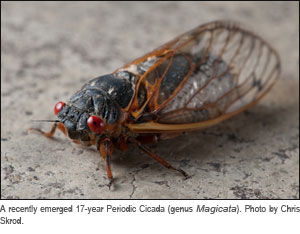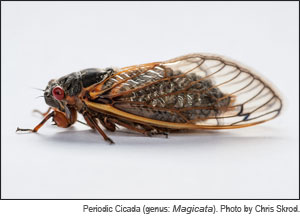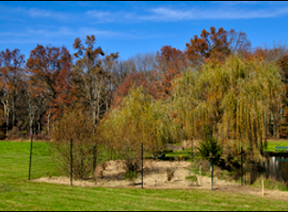

Cicadas have emerged en masse, after 17 years in the ground. They are clambering into trees and singing a distinctive chorus that can be heard for miles because of their numerous voices. While there are many kinds of cicadas, these 17-year cicadas are a specific genus of cicada, called Periodical Cicadas (genus: Magicicada).
What makes this event so remarkable is that it results from 17 years of preparation. The now emerging army of Periodical Cicadas was born in 1996. Their mothers laid their eggs in the branches of trees. There they developed for a few weeks before hatching and heading for the ground. These larvae then squirmed into the dirt and spent the next 17 years sucking fluid from tree and plant roots.
Millions of cicada nymphs have now climbed from the ground in which they have spent nearly two decades. They will have morphed from wingless to winged creatures, and taken to the trees for their famously noisy courtship. The empty husks of the nymph-stage bugs are seemingly everywhere. Now, the newly emerged animals single-mindedly seek to mate and produce the next generation. And shortly after mating and after the eggs are laid, the adults will die. Surprisingly, cicadas barely eat a thing during their time above ground.
Their time in the sun is short, but their 17-year life span makes them the longest-lived insects known.
Cicadas will not emerge in everyone’s back yard. If there are no deciduous trees—trees that lose their leaves each fall, like maples, oaks and fruit trees—probably no cicadas will be seen. Pesticides, construction, extreme weather conditions, and tree removal are also factors reducing the incidence of cicadas. The overall emergence time for cicadas in a particular location typically is 4 to 6 weeks from the time the first nymph crawls from the ground, until the last adult dies.


Periodic Cicadas don’t bother to escape when confronted, and that is because they do not have to escape. Since they emerge in such HUGE numbers, some members of their species are bound to survive no matter what. They can devote their limited energy and time above ground to calling and mating, rather than running away from each and every possible predator. This strategy may explain how an insect that neither bites nor stings, has managed to thrive.
Are cicadas locusts? No, true locusts belong in the same family of insects as grasshoppers. The confusion stems from the fact that both locusts and cicadas emerge in periodic swarms. But, locusts are far more destructive, destroying all plant life in their path. Cicadas do fly around trees and kill a few weakling branches here and there. They DO NOT kill flowers and would not damage shrubs and trees, unless the latter are young and immature. Cicadas do not damage tree leaves by chewing them as other insects do. Unlike grasshoppers and caterpillars, cicadas do not eat garden vegetables. They lack mouth parts that would enable them to chew.
Probably it is not a good idea to combat cicadas with pesticides. New cicadas will continually fly onto your trees from neighboring yards, making pesticides futile. Also, your pets could become poisoned from ingesting too many treated cicadas. Importantly, you will want to avoid the unintended collateral damage of killing honey bees and butterflies by using pesticides to disable cicadas.
While cicadas in your back yard are a bit of a nuisance, remember that you are not going to see Periodic Cicadas again until the year 2030.



